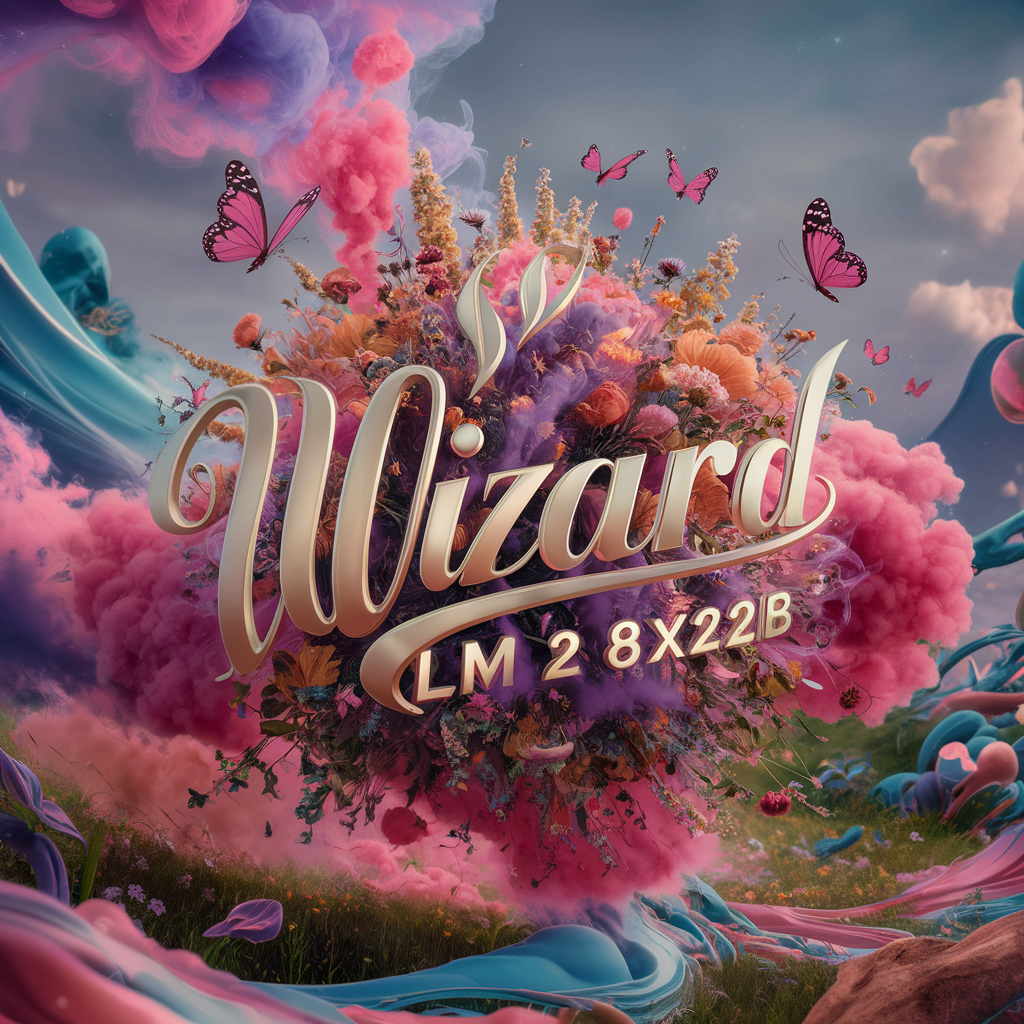wizardlm-2-8x22b
Maintainer: camenduru

1

| Property | Value |
|---|---|
| Run this model | Run on Replicate |
| API spec | View on Replicate |
| Github link | View on Github |
| Paper link | View on Arxiv |
Create account to get full access
Model overview
The wizardlm-2-8x22b is a large language model developed by Replicate, a company focused on making AI models accessible and usable. This model is related to other Replicate models like VoiceCraft, which enables zero-shot speech editing and text-to-speech, and Qwen1.5-110B, a transformer-based decoder-only language model. The wizardlm-2-8x22b is a powerful text generation model that can be used for a variety of tasks.
Model inputs and outputs
The wizardlm-2-8x22b model takes a text prompt as input and generates an output text sequence. The input prompt can be customized with various parameters, such as temperature, top-k, and top-p, to control the creativity and coherence of the generated text. The output is an array of text strings, which can be concatenated to form the full generated text.
Inputs
- Prompt: The initial text prompt to guide the model's generation.
- Temperature: A float that controls the randomness of the sampling, with lower values making the model more deterministic and higher values making it more random.
- Top K: An integer that controls the number of top tokens to consider during generation.
- Top P: A float that controls the cumulative probability of the top tokens to consider.
Outputs
- Generated Text: An array of text strings representing the model's generated output.
Capabilities
The wizardlm-2-8x22b model is a powerful text generation model that can be used for a variety of tasks, such as creative writing, story generation, and dialogue systems. The model has been trained on a large corpus of text data and can generate coherent and contextually relevant text. It can also be fine-tuned on specific domains or tasks to improve its performance.
What can I use it for?
The wizardlm-2-8x22b model can be used for a variety of applications, such as creative writing, story generation, and dialogue systems. For example, you could use the model to generate creative short stories, develop interactive chatbots, or assist with content creation for various industries.
Things to try
One interesting aspect of the wizardlm-2-8x22b model is its ability to generate text with a high degree of coherence and context-awareness. You could experiment with different prompts and parameter settings to see how the model responds to different types of inputs, or try fine-tuning the model on a specific domain or task to improve its performance.
This summary was produced with help from an AI and may contain inaccuracies - check out the links to read the original source documents!
Related Models

lgm

3
The lgm model is a Large Multi-View Gaussian Model for High-Resolution 3D Content Creation developed by camenduru. It is similar to other 3D content generation models like ml-mgie, instantmesh, and champ. These models aim to generate high-quality 3D content from text or image prompts. Model inputs and outputs The lgm model takes a text prompt, an input image, and a seed value as inputs. The text prompt is used to guide the generation of the 3D content, while the input image and seed value provide additional control over the output. Inputs Prompt**: A text prompt describing the desired 3D content Input Image**: An optional input image to guide the generation Seed**: An integer value to control the randomness of the output Outputs Output**: An array of URLs pointing to the generated 3D content Capabilities The lgm model can generate high-resolution 3D content from text prompts, with the ability to incorporate input images to guide the generation process. It is capable of producing diverse and detailed 3D models, making it a useful tool for 3D content creation workflows. What can I use it for? The lgm model can be utilized for a variety of 3D content creation tasks, such as generating 3D models for virtual environments, game assets, or architectural visualizations. By leveraging the text-to-3D capabilities of the model, users can quickly and easily create 3D content without the need for extensive 3D modeling expertise. Additionally, the ability to incorporate input images can be useful for tasks like 3D reconstruction or scene generation. Things to try Experiment with different text prompts to see the range of 3D content the lgm model can generate. Try incorporating various input images to guide the generation process and observe how the output changes. Additionally, explore the impact of adjusting the seed value to generate diverse variations of the same 3D content.
Updated Invalid Date

wizard-mega-13b-awq

5
wizard-mega-13b-awq is a large language model (LLM) developed by nateraw that has been quantized using Adaptive Weight Quantization (AWQ) and served with vLLM. It is similar in capabilities to other LLMs like nous-hermes-llama2-awq, wizardlm-2-8x22b, and whisper-large-v3. These models can be used for a variety of language-based tasks such as text generation, question answering, and language translation. Model inputs and outputs wizard-mega-13b-awq takes in a text prompt and generates additional text based on that prompt. The model allows you to control various parameters like the "top k" and "top p" values, temperature, and the maximum number of new tokens to generate. The output is a string of generated text. Inputs message**: The text prompt to be used as input for the model. max_new_tokens**: The maximum number of tokens the model should generate as output. temperature**: The value used to modulate the next token probabilities. top_p**: A probability threshold for generating the output. If = top_p (nucleus filtering). top_k**: The number of highest probability tokens to consider for generating the output. If > 0, only keep the top k tokens with highest probability (top-k filtering). presence_penalty**: The presence penalty. Outputs Output**: The generated text output from the model. Capabilities wizard-mega-13b-awq is a powerful language model that can be used for a variety of tasks. It can generate coherent and contextually-appropriate text, answer questions, and even engage in open-ended conversations. The model has been trained on a vast amount of text data, giving it a broad knowledge base that it can draw upon. What can I use it for? wizard-mega-13b-awq can be used for a wide range of applications, such as: Content generation**: The model can be used to generate articles, stories, or other types of written content. Chatbots and virtual assistants**: The model can be used to power conversational AI agents that can engage in natural language interactions. Language translation**: The model can be fine-tuned for translation tasks, allowing it to translate text between different languages. Question answering**: The model can be used to answer questions on a variety of topics, drawing upon its broad knowledge base. Things to try One interesting thing to try with wizard-mega-13b-awq is to experiment with the different input parameters, such as temperature and top-k/top-p values. Adjusting these can result in significantly different output styles, from more creative and diverse to more conservative and coherent. You can also try prompting the model with open-ended questions or tasks and see how it responds, as this can reveal interesting insights about its capabilities and limitations.
Updated Invalid Date

wizardcoder-15b-v1.0

2
The wizardcoder-15b-v1.0 is a large language model created by the Replicate user lucataco. It is a variant of the WizardLM family of models, which have shown impressive performance on tasks like code generation. While not much is known about the specific architecture or training process of this particular model, it is likely a powerful tool for a variety of natural language processing tasks. When compared to similar models like the wizardcoder-34b-v1.0, wizard-mega-13b-awq, wizardlm-2-8x22b, and WizardLM-13B-V1.0, the wizardcoder-15b-v1.0 appears to be a more compact and efficient version, while still maintaining strong capabilities. Its potential use cases and performance characteristics are not entirely clear from the available information. Model inputs and outputs Inputs prompt**: A text prompt that the model will use to generate a response. max_new_tokens**: The maximum number of new tokens the model will generate in response to the prompt. temperature**: A value that controls the randomness of the model's output, with lower values resulting in more focused and deterministic responses. Outputs output**: The text generated by the model in response to the input prompt. id**: A unique identifier for the model run. version**: The version of the model used. created_at**: The timestamp when the model run was initiated. started_at**: The timestamp when the model run started. completed_at**: The timestamp when the model run completed. logs**: The logs from the model run. error**: Any errors that occurred during the model run. status**: The status of the model run (e.g., "succeeded", "failed"). metrics**: Performance metrics for the model run, such as the prediction time. Capabilities The wizardcoder-15b-v1.0 model appears to be a capable code generation tool, as demonstrated by the example of generating a Python function to check if a number is prime. Its ability to produce coherent and relevant code snippets suggests it could be useful for tasks like software development, data analysis, and automation. What can I use it for? The wizardcoder-15b-v1.0 model could be a valuable tool for developers and data scientists looking to automate or streamline various tasks. For example, it could be integrated into an IDE to assist with code completion and generation, or used to generate boilerplate code for common programming tasks. Additionally, it could be employed in data analysis workflows to generate custom scripts and functions on demand. Things to try One interesting thing to try with the wizardcoder-15b-v1.0 model would be to explore its capabilities in generating more complex code, such as multi-function programs or algorithms that solve specific problems. It would also be worthwhile to experiment with different prompting strategies and temperature settings to see how they affect the model's outputs and performance.
Updated Invalid Date

wizardcoder-33b-v1.1-gguf

20
WizardCoder-33B-V1.1 is an AI model developed by lucataco that is part of the WizardCoder family. It is an improvement upon the earlier WizardCoder-15B-V1.0 and WizardCoder-34B-V1.0 models, achieving better performance on benchmarks like HumanEval and MBPP. The model is designed to empower code-oriented large language models with the Evol-Instruct technique. Model inputs and outputs WizardCoder-33B-V1.1 takes in a text prompt as input, which can include an instruction for the model to carry out. The model then generates a text response that completes the requested task. Inputs Prompt**: The instruction or text the model should use to generate a response. System Prompt**: A default prompt that helps guide the model's behavior. Temperature**: A parameter that controls how "creative" the model's response will be. Repeat Penalty**: A parameter that discourages the model from repeating itself too much. Max New Tokens**: The maximum number of new tokens the model should generate. Outputs Text Response**: The model's generated text completing the requested task. Capabilities WizardCoder-33B-V1.1 has been shown to outperform several closed-source and open-source models on programming-related benchmarks like HumanEval and MBPP. It can generate original code to complete a wide variety of coding tasks, from writing a simple snake game in Python to more complex programming challenges. What can I use it for? WizardCoder-33B-V1.1 could be used for a range of applications involving code generation, such as aiding software developers, automating certain programming tasks, or even as a starting point for building custom AI applications. The model's strong performance on benchmarks suggests it may be particularly useful for tasks like prototyping, debugging, or generating boilerplate code. Things to try One interesting thing to try with WizardCoder-33B-V1.1 would be to give it increasingly complex or open-ended coding challenges to see how it performs. You could also experiment with adjusting the temperature and repeat penalty parameters to find the sweet spot for your specific use case. Additionally, comparing the model's outputs to those of other code-oriented language models could yield interesting insights.
Updated Invalid Date